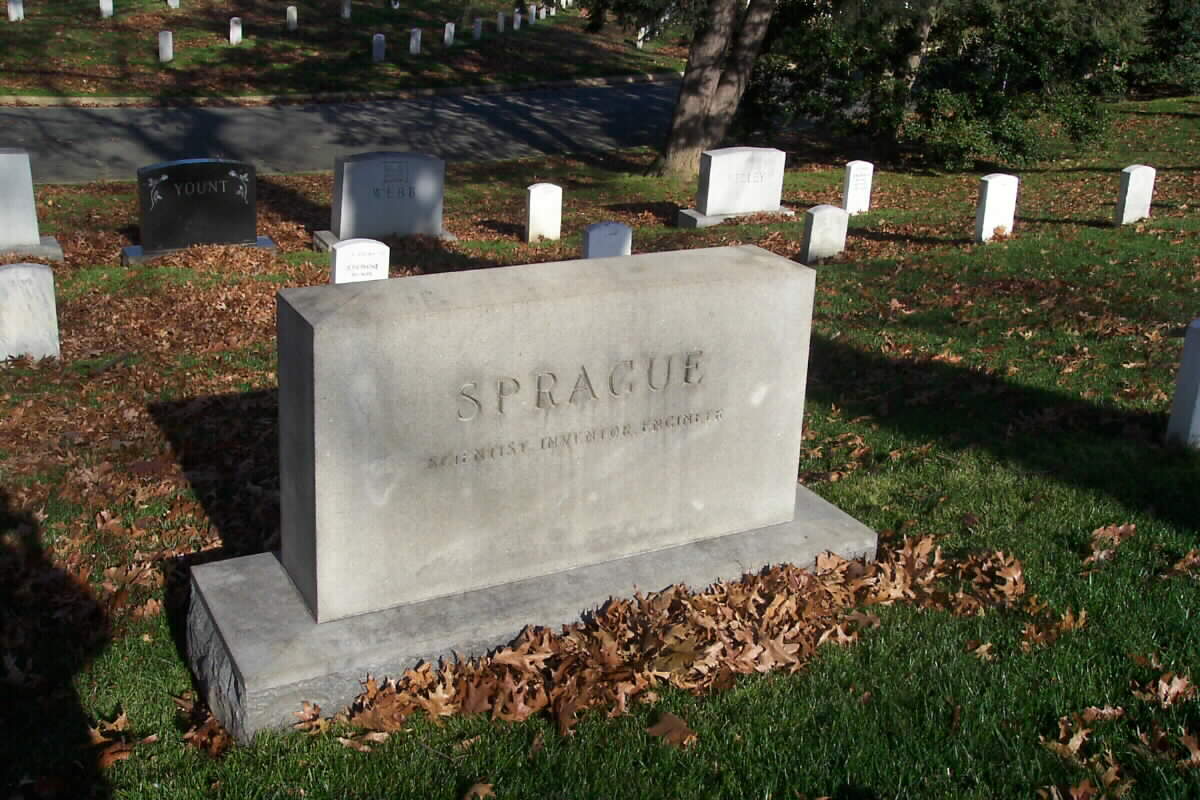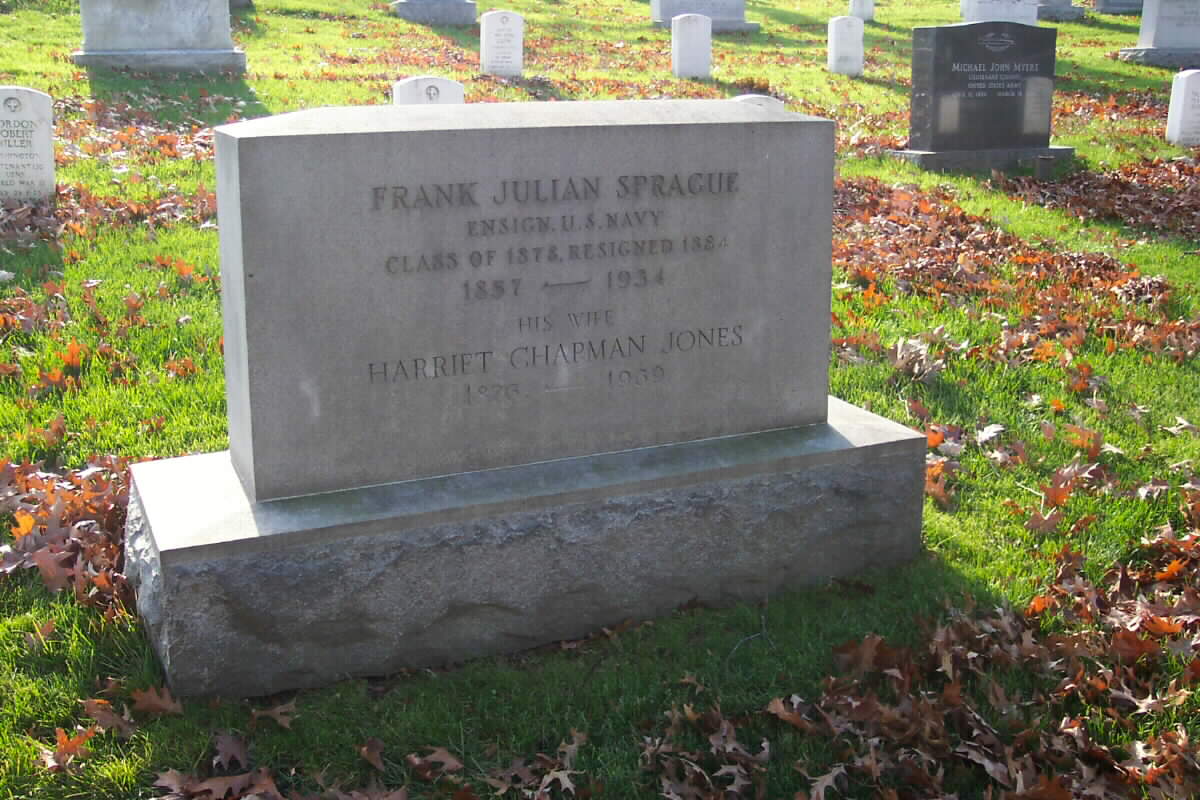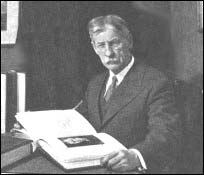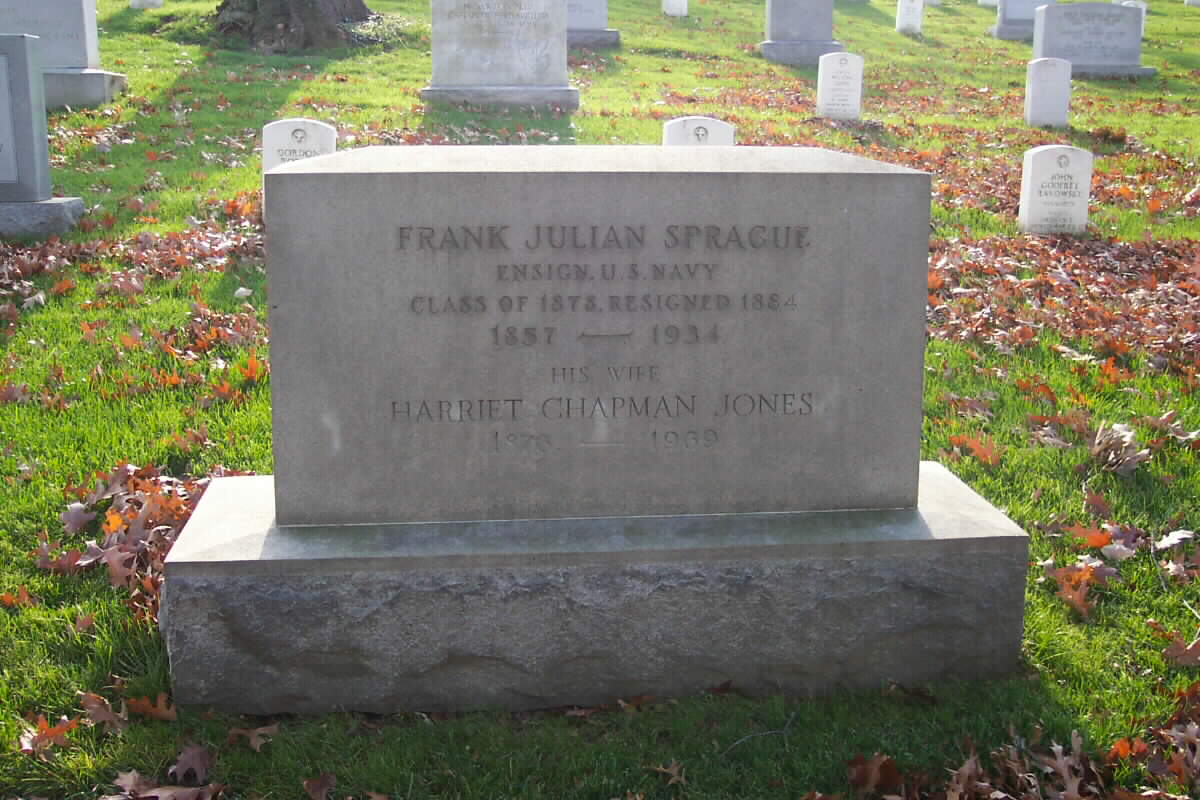Sprague, Frank Julian , 1857–1934, American electrical engineer, born at Milford, Connecticut, graduated from the United States Naval Academy at Annapolis, Maryland, in 1878.
He was an assistant to Thomas Edison in 1883 and independently created a superior electric motor that was readily adaptable to industrial machinery. He also improved systems of electric energy and wheel suspension systems from which he developed the first electric street railway, installed at Richmond, Virginia, in 1887.
He contributed greatly to the development of electric railways by inventing the multiple-unit system of automatic control, an automatic brake, and numerous other devices; he also developed the electric elevator.
Frank J. Sprague
Hailed during his lifetime as the “Father of Electric Traction” by leaders in the fields of science, engineering and industry, Frank Julian Sprague’s achievements in horizontal transportation were paralleled by equally remarkable achievements in vertical transportation. During a six-decade career, Sprague distinguished himself as an inventor for his accomplishments in the development of the electric railway, early electric elevators and the commercial electric motor. Sprague was born in Milford, Connecticut in 1857. He attended Drury High School and excelled in mathematics. Sprague won the appointment to the U.S. Naval Academy, and with US $400 in borrowed cash, set out for Annapolis, Maryland, in 1874.
Graduating seventh in a class of 36 in 1878, Sprague was assigned to the USS Richmond, flagship of the Asiatic Fleet, where he filled a notebook with detailed drawings and descriptions of devices that evidenced his urge for invention. Among these were a duplex telephone, quadruplex and octoplex telegraph systems, a motor and a means of transmitting pictures by wire. Later, Sprague was ordered to the USS Minnesota. While his ship was in Newport, Rhode Island, in 1881, Sprague invented the inverted type of dynamo. Also in 1881, Spraque transferred to the USS Lancaster, flagship of the European Squadron, on which he installed the first crude electrical call-bell system in the Navy.
Sprague took leave to attend the Paris Electrical Exhibition and the Crystal Palace Exhibition in Sydenham, England, where he served as the only American member and as secretary of the jury of awards for gas engines, dynamos and lamps.
Meanwhile, Sprague’s ideas about motors and lamps had so impressed E.H. Johnson, a business associate of Thomas A. Edison, that he convinced Sprague to resign from the Navy in 1883 to become a technical assistant to Edison. While on Edison’s staff, Sprague assisted in the installation and operation of Edison’s pioneer three-wire electric light systems. Sprague also revised and corrected the Edison system of mains and feeders for central station distribution and developed a formula for determining the ratio of wire size to current amperage.
However, Edison’s primary interest was in light, while Sprague was interested in power. He resigned his position after about a year and started the Sprague Electric Railway & Motor Company in 1884. During the next two years, Sprague produced a number of inventions of major significance.
The first was a constant-speed, nonsparking motor with fixed brushes. The first motor to maintain constant revolutions per minute under different loads. Sprague’s invention caused such a stir at its first showing at the Franklin Institute’s Electrical Exhibition in Philadelphia that the company sold 250 motors in two years.
In 1885, the Edison Electric Light Company officially endorsed Sprague’s motor in a circular sent to its local companies. “A practical motor has been a want seriously felt in our system,” it read. “The Sprague motor is believed to meet . . . all the exigencies of the case, and the Edison Electric Light Company feels it can safely recommend it to all its licensees as the only practical and economic motor existing today.”
Next, Sprague designed a method to regenerate — or return — power to the main supply systems of electric-motor-driven equipment, such as elevators and trains for economy and braking. This was later used extensively on mountain grades in electrical train operation and for interchange of energy in elevator groups. Additionally, Sprague developed a distorted system of compound field magnet winding that maintained a fixed nonsparking position of commutator brushes and a three-point, wheelbarrow suspension of axle-mounted geared motors for electric railways, which was soon used universally for trolley-car equipment.
Sprague incorporated many of these inventions in the equipment his company installed for the Richmond (VA) Union Passenger Railway in 1887-1888, the first large-scale electric trolley line in the world. Within two years of its opening, 110 electric railroads using Sprague’s equipment were built or under contract, including systems in Italy and Germany.
In 1890, Edison General Electric Company, which manufactured much of Sprague’s equipment, purchased and absorbed the Sprague Electric Railway & Motor Company, and Sprague turned his attention to the field of vertical transportation.
The Richmond Line’s increased passenger capacity and speed gave Sprague the notion that similar results could be achieved in vertical transportation. He saw that increasing the capacity of elevator shaftways would not only save passengers’ time, but would also increase the earnings of tall buildings, the height of which was limited by the total floor space taken up by the shaftways slow-running elevators. Although hydraulic elevators were adequate for buildings of ordinary height, steam elevators were much in use and electric elevators existed, none met the demand for higher speeds at longer runs required in skyscrapers. Sprague knew electricity would significantly improve elevator operation, but his ideas met with intense opposition from the hydraulic elevator companies, architects, builders and building owners. Nonetheless, in 1892, Sprague formed the Sprague Electric Elevator Company, and with Charles R. Pratt, developed the Sprague-Pratt Electric Elevator. The Postal Telegraph Company purchased some of these direct-operated electric elevators with multiplying sheaves, electric braking and distant pilot control for installation in its New York City building, but the company demanded that Sprague guarantee installation of any hydraulic system the customer desired should his elevators fail. Sprague never had to make good his guarantee. He ran four of his elevators at 325 feet per minute with 2500-pound loads and the other two at 400 feet per minute with 1800-pound loads.
In the years ahead, Sprague’s company developed floor control, automatic elevators, acceleration control of car safeties and a number of freight elevators. And Sprague continued experimenting with the motor in the Postal Telegraph Building. He connected individual control circuits to a master control switch to operate all the elevators at the same time. Sprague’s idea worked. However, the cars’ operations were hardly synchronous, and he continued to ponder the problem.
While developing small pilot motors and other control devices operated by signaling circuits from the car to indirectly affect the hoisting machinery, Sprague realized he had not only discovered a means to more rapidly, precisely and flexibly controlling a car, but also a means of controlling cars in groups.
After building 584 elevators for the tallest buildings and the largest installation — a half-million-dollar, 49-car contract with the Central London Tube Railway — Sprague sold his business to the Otis Elevator Company.
In 1895, Sprague parlayed his experience with elevator control to devise a multiple-unit system of electric railway operation, a revolutionary development in the field of electric traction.
For the next five years, Sprague served on the Commission for Terminal Electrification of the New York Central Railroad, including the Grand Central Region. Then, in an effort to make railway travel safer, Sprague designed a system of automatic train control that enforced compliance with trackside signals and formed the Sprague Safety Control & Signal Corporation to develop and build it.
In the late 1920s, vertical transportation again caught Sprague’s attention, and he devised a method for safely running two independent elevators, local and express, in a single shaft to conserve floor space. To operate the elevators in this way, Sprague provided a floating lower limit for the upper car and a similar floating upper limit for the lower car, which were jointly controlled and actuated through differential action of the main controllers.
Sprague quickly built the first working model and sold his dual-elevator system, along with a method for actuating the car safeties by excess acceleration, as well as by excess speed, to the Westinghouse Company.
During his career, Sprague earned the gold medal at the Paris Electrical Exhibition in 1889, the grand prize at the St. Louis Exhibition in 1904 and the Edison Medal of the American Institute of Electrical Engineers in 1910. The Franklin Institute awarded him the Elliott-Cresson Medal in 1904 and the Franklin Medal in 1921.
Three days before he died on October 25, 1934, Sprague was notified that representatives of four national engineering societies had selected him to received the John Fritz Gold Medal for 1935. “All through his life and up to his last day, Frank Sprague had a prodigious capacity for work,” his son Robert wrote in 1935.
“And once having made up his mind on a new invention or a new line of work, he was tireless and always striving for improvement. He had a brilliantly alert mind and was impatient of any half-way compromise. His interest in his work never ceased; only a few hours before the end, he asked to have a newly designed model of his latest invention brought to his bedside.”
Evelyn Jutte is a freelance researcher, writer and editor who lives in Mitchellville, Maryland. A native of St. Marys, Ohio, Jutte retired from the Navy in 1994 after serving 20 years as a public affairs specialist, writer/editor and journalism instructor.
FUNERAL RITES TODAY FOR FRANK J. SPRAGUE
Many Notables Are Pallbearers for Service for Inventor at the West End Church
NEW YORK, New York, October 27, 1934 – A funeral service will be held at 2 P.M. today at the West End Collegiate Church, Seventh-Seventh Street and West End Avenue, for Frank Julian Sprague, noted investor of electrical devices, who was known as the “father of electric traction.” The Rev. Dr. Henry E. Cobb, pastor emeritus of the church and the Rev. Edward M. Chapman of the New London, Connecticut, brother-in-law of Mrs. Harriet C. J. Sprague, widow of Mr. Sprague, will officiate.
Honorary pallbearers at the funeral will be: Sr, Cary t. Hutchinson, Frank. H. Shepard, Alexander McIver, Hugh Pattison, Bancroft Gherardi, Dr. Frank B. Jewett, Philip Torchio, Edward R. Hewitt, Thomas Robins, Frank Hedley, Colonel W. L. Wilgus, Gerard Swope, Thomas Ewing, Robert Lundell, L. P. Gramer, Ellwood Colahan, W. L. R. Emmet, J. S. Tritle, Rear Admiral S. S. Robison, Rear Admiral Bradley S. Fiske and G. A. Robinson.
Also Frank R. Philipps, Charles Gordon, Bion J. Arnold, Major Charles A. Benton, Professor Michael L. Pupin, J. Allen Johnson, C. O. Bradshaw, Dr. Dugald C. Jackson, Oliver Berford, Hermann Irion, Julian Street, Horace B. Mann and F. Luis More.
The chief usher at the funeral will be E. D. Dorting.
Burial will take place in Arlington National Cemetery on Monday afternoon. A Naval guard of honor will participate in the burial ceremony. Mr. Sprague, a Untied States Naval Academy graduate, had resigned as an officer of the Navy in 1883 but had been associated with the Navy for many years thereafter.
Mrs. Sprague died on Thursday at his home, 40 West Fifty-Firth Street, at the age of 77.
SPRAGUE, FRANK JULIAN
- ENSIGN U S NAVY
- VETERAN SERVICE DATES: Unknown
- DATE OF DEATH: 10/25/1934
- DATE OF INTERMENT: 10/29/1934
- BURIED AT: SECTION 4 SITE 2959
ARLINGTON NATIONAL CEMETERY
SPRAGUE, HARRIET WIDOW OF FRANK JULIAN
- DATE OF BIRTH: 01/07/1876
- DATE OF DEATH: 10/01/1969
- DATE OF INTERMENT: 10/07/1969
- BURIED AT: SECTION 4 SITE 2959 WH
- ARLINGTON NATIONAL CEMETERY
- WIFE OF FJ SPRAGUE – ENSIGN US


Michael Robert Patterson was born in Arlington and is the son of a former officer of the US Army. So it was no wonder that sooner or later his interests drew him to American history and especially to American military history. Many of his articles can be found on renowned portals like the New York Times, Washingtonpost or Wikipedia.
Reviewed by: Michael Howard


